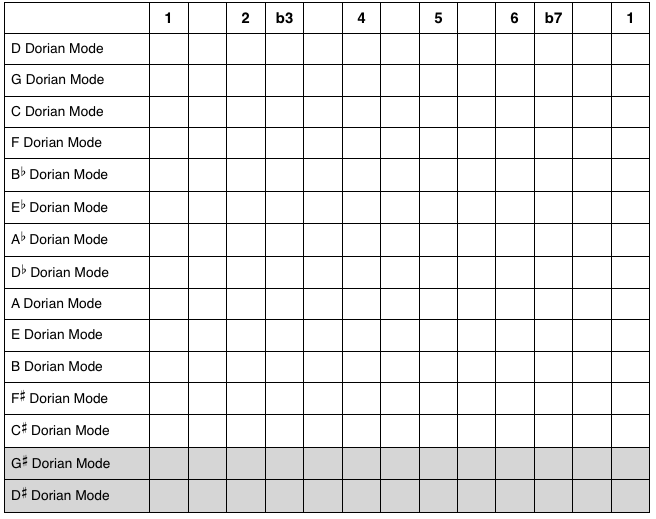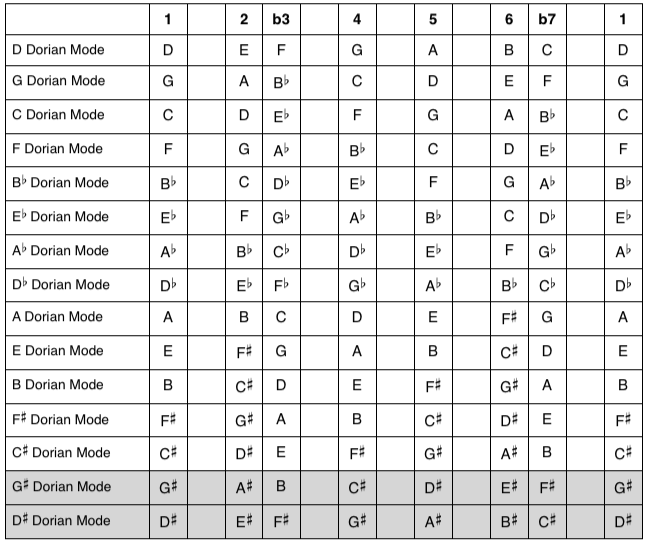In this lesson we’re going to take a look at some of the theory related to the dorian mode. If you’ve never heard of this scale before, then you’ll be pleased to know that it’s an incredibly useful scale that can add a lot of flavor to your guitar solos.
To my ears, the dorian mode has a really jazzy sound. (This isn’t surprising, since it’s the go to scale that’s used over minor seventh chords in jazz). But, don’t worry. Using the dorian mode won’t automatically make you sound like a jazz guitarist. (Phew!). Just crank up the distortion, and employ copious string bends, and you’ll soon discover that you can make it work in a rock setting. Check out the playing of Joe Satriani and Steve Vai if you need evidence of this. 🙂
I’ll be giving you a practical way of applying the dorian mode nearing the end of the lesson. But, before we look at that, it’s important to cover all the theory stuff first. Ya gotta eat your vegetables before you can have your dessert. 🙂
Musical Spelling
![]()
As you can see, the musical spelling of the dorian mode is essentially a major scale with a b3 and b7. Although this two note difference might not seem like a big deal. You’ll find that it makes a profound difference to the sound of the scale.
How To Use The Musical Spelling
If you’re already very comfortable with using musical spellings, then you’ll find it pretty easy to work out the notes of the dorian mode. But, it’s probably still a good idea to take a very quick look at an example. To do this, we’ll now work out the notes of the A Dorian mode…
Example: A Dorian Mode
To work out the notes of the A Dorian mode, you’ll need to follow these two steps…
Step 1: Write down the notes of the A major scale. Doing this, will give us these notes…

Step 2: Because the dorian mode has a b3 and b7, this means that we have to lower the third and seventh notes of the A major scale by one half-step. Doing us will leave is the notes of the A Dorian mode…

Demonstration Video
On the video below I show you how to use the musical spelling of the dorian mode to turn a major scale fingering into a dorian mode scale fingering. As well as this, I’ve also done a short improvised solo to show you the dorian mode being used in a musical context.
Now It’s Your Turn
If you’ve already worked through the lessons on the lydian mode and mixolydian mode, then you should know the drill by now. 🙂
Please take the time to fill in the table below. To do this, I highly recommend working out just a few keys each day. This will not only make the process of completing the table far less torturous, you’ll also find that the daily repetition will help with the learning process tremendously.
Pay close attention to the last two keys in the table. (These are the ones that I’ve highlighted in grey). Because there is no G# major scale, and no D# major scale, this means that you won’t be able to use the method we’ve just talked about to work them out. Instead, what I recommend doing are the following two steps…
- Work out the dorian mode that’s one half-step lower. For Example: If you wanted to work out the notes of G# Dorian, you would first work out the notes of G Dorian.
- After you’ve worked out the notes in the key that’s one half-step lower, raise all the notes by one half-step. For Example: To work out the notes of G# Dorian, you would need to raise all the notes of the G Dorian mode by one half-step.

Once you’ve filled out the table, then you can check your answers below…
The Answers
Here is the completed table. If you made any mistakes, please make sure that you work out where you went wrong.

Putting This Music Theory Into Practice
In my opinion, it’s very important to put this music theory immediately into practice. (What’s the point of learning theory without actually using it?). To help you do this, we’ll now look at an application exercise. Please do these steps now…
- Memorise the single string scale fingering for the A Dorian mode shown below. Please ensure that you take the time to memorize the note names and scale degrees that are shown above the TAB. (Doing this will help you to understand the musical meaning of what you’re learning).

- Using the scale fingering you memorised in Step 1, improvise over the backing track that I’ve provided. As you play over the backing track, listen closely to the sound of every note that you play. My favourite sounding note is the 6, because I think it’s got a nice sharp “edge” to it. Of course, feel free to disagree with my preference. It’s important that you take the time to work out what you like the most. 🙂
- Once you’ve finished your improvisation, write down your general thoughts on what you think the dorian mode sounds like.
A Few Last Words
That’s it for another fun-filled lesson on modes. Have fun with this stuff, and I’ll look forward to sharing some more useful information about the dorian mode in the next lesson.
Have fun!
Return To: Guitar Music Theory Lessons